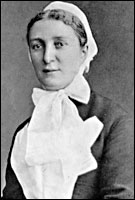![]()
The contents on this page remain on our website for informational purposes only.
Content on this page will not be reviewed or updated.
 |
|
 |
|
|
||||
|
Little Woolstone: Sister Dora
|
||||
|
||||
|
How times change, and not least in education. During my schooldays the ‘internet’ consisted of a set of Encyclopaedia Britannica, stored on suitably stout shelving in the local library. Whilst as for ‘text messaging,’ the nearest we had was passing grubby bits of paper around the class, not infrequently to the blonde bombshell at the back who, by dint of looks, and certain other attributes, held the monopoly of being able to pick and choose from the spotty herberts vying for her attention. Yes, it would certainly be a shock for today’s generation to endure the classroom of 50 years ago. Yet this would be nothing compared to the teaching methods of earlier times, for it was not without good reason that Dr. Richard Busby, the headmaster of Westminster School, was known as ‘Sir Richard Birch-Hard.’ ‘Addicted to flogging,’ he literally left a lifelong impression upon many of his notable scholars, whilst as for his local impression, this he left in the form of the architectural excellence of Willen church (designed by Robert Hooke), which was built following his purchase of the manor. Another teacher of local renown - albeit of a more benign philosophy - was Dorothy Wyndlow Pattison, who is considered by many to have been a civilian counterpart to Florence Nightingale. As a child, Dorothy had lived in the Yorkshire village of Hauxwell, but she suffered so badly from a weak chest that she often had to stay away from school, and it would be during these absences that she indulged in ‘washing and attending to people and dolls.’ Seeking escape from a rather unhappy home life, Dorothy had considered joining Florence Nightingale’s Sisters of Mercy, but since this was forbidden by her father, instead in 1860 she answered an advertisement for a schoolmistress at Little Woolstone, being duly chosen from the 25 applicants. Until the schoolteacher’s house was complete she stayed at the rectory at Great Woolstone, and apart from her primary role as a teacher she would also nurse any pupils who fell ill. Yet eventually the strains proved too much, and she had to return to her Yorkshire home. However, when recovered instead of resuming her teaching career she joined the nursing ‘Sisterhood of the Good Samaritan’ at Redcar, and being known as ‘Sister Dora’ in 1865 undertook hospital work at Walsall, in Staffordshire. Unfortunately, due to her conscientious devotions her heath began to suffer, and in 1878 she died at the age of 46, with her wish having been that ‘no vain eulogy’ should be made to her. But nevertheless a statue was unveiled in the market place at Walsall in October 1886, whilst at Little Woolstone a small locally made plaque was placed in the church, on the north wall of the nave. Later, this was moved during the New City restorations to the chancel, and it was also due to the New City that Pattison Lane came into being, as a further commemoration of the famous schoolmistress. As for today’s education, Dorothy would no doubt be pleased that the little petals no longer have to endure corporal punishment, and of course any oik worth their salt will now be fully clued up on ‘Human Rights.’ And so to the surviving kin of Miss Nora Bone (real name withheld for legal reasons) I say beware. For regarding that clip round the ear I received in 1959, for knocking over the water pot during the art lesson, I shall be advising my ‘no win, no fee’ lawyers to seek substantial ‘compo’ for ‘hurt feelings,’ contravention of the E.U.s ‘Dignity at School’ policy (I’m sure there must be one), not to mention the constant ‘flashbacks’ and stress related illness. And besides, I reckon most of the kids’ paintings looked a darn sight better, having been smudged with 2½ pints of murky tap water.
|
||||
|
|
||||
|
|
||||


